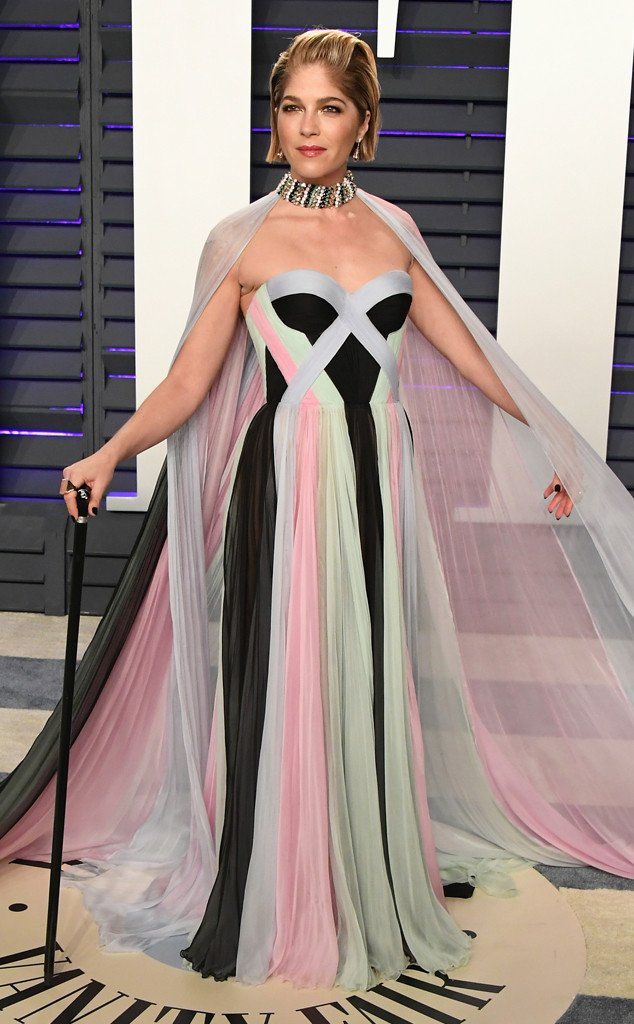
Jon Kopaloff/WireImage
It was sometime in the evening of August 16, 2018 that Selma Blair‘s life changed for good.
To be fair, it had already changed prior to that night, what with the last five years of puzzling and painful symptoms that seemed to come and go without rhyme or reason; the neck pain, the vertigo, the anxiety, the trouble walking, the crippling fatigue. There was something wrong, some great betrayal of body afoot—and yet, no one could figure out exactly what it was.
Blair heard all sorts of theories for her symptoms: depression, hormones, the dramatic hysterics of a Hollywood actress.
But it wasn’t until, after seeking out the only solution she’d come across able to temporarily soothe her distress—a steroid shot to quell the neck pain—a new doctor insisted on an M.R.I. that she got the answers she’d been so desperate to find. And after the gigantic imaging machine began to do its thing, photographing her brain, the neurologist informed Blair that the 20 lesions covering the organ meant that she was likely suffering from multiple sclerosis, a chronic and unpredictable disease of the central nervous system that disrupts its ability to communicate with the rest of the body.
It was a moment that was long time coming for the actress, who’d, up until a terrifying 2016 incident on an airplane saw her making tabloid headlines after she had what she’d described, pre-MS diagnosis, as a “total psychotic blackout,” prompted her to drop booze cold turkey, taken to self-medicating with alcohol while she grappled with the emotional fallout that comes along with a failing body.
“I was ashamed and I was doing the best I could and I was a great mother, but it was killing me,” Blair told ABC News‘ Robin Roberts in late February of this year. “And so when I got the diagnosis I cried with some relief. Like, ‘Oh, good, I’ll be able to do something.'”
“I had tears. They weren’t tears of panic,” she reiterated of that life-changing night. “They were tears of knowing I now had to give in to a body that had loss of control, and there was some relief in that.”

Since that August night, Blair has had a few more moments that have similarly shifted her world yet again. There was the day in October that she went public with her diagnosis by way of a detailed Instagram post dispatched from the set of her Netflix series Another Life meant to, in part, praise the producers and crew who had taken her limitations in stride. “I am disabled. I fall sometimes. I drop things. My memory is foggy. And my left side is asking for directions from a broken gps,” she wrote. “But we are doing it. And I laugh and I don’t know exactly what I will do precisely but I will do my best.”
The attention her announcement received left the actress, who, despite her turns in classic films like Cruel Intentions, Legally Blonde and The Sweetest Thing, thinks of herself as “pretty much a nobody in Hollywood,” feeling surprised.
“It wasn’t about announcing a dramatic diagnosis. I had no idea, for some reason, that news outlets would pick it up or anything. When they did, I was kind of uncomfortable. Then I was worried, thinking, ‘Will anyone hire me?'” Blair said in Vanity Fair‘s March 2019 issue, before wryly noting, “I reconnected with so many people who thought I might drop dead soon.”
And then there was the night in late February when she made her return to the spotlight on the red carpet at the 2019 Vanity Fair Oscar Party, debuting both her new short, blonde bob and her chic cane in a moment so triumphant and fraught with emotion that it left Blair in tears and had the photogs uncharacteristically applauding the actress’ spirit.
The appearance kicked off a week that would see her exclusive sit-down with Roberts and her VF feature make their respective debuts, all the culmination of months that saw Blair’s condition continue to deteriorate—”I…never thought I’d get this bad, to tell you the truth,” she admitted to Vanity Fair—while instilling her with a greater mission.
“There’s no tragedy for me,” she told the magazine. “I’m happy, and if I can help anyone be more comfortable in their skin, it’s more than I’ve ever done before.”

Emma McIntyre /VF19/WireImage
During her chat with Roberts, it became clear just how marked the effects of the disease have been on the actress. Explaining to the Good Morning America anchor that she was in an “exacerbation” of MS, an attack that can cause new symptoms or the worsening of existing ones, Blair spoke with a vocal tremor brought on by spasmodic dysphonia, a disorder that affects the voice muscles in the larynx.
“It is interesting to put it out there, to be here to say, ‘This is what my particular case looks like right now,'” she told Roberts. Adding that, despite dealing with the flare-up, she was doing “very well,” Blair said she was happy to be able to show the world “what being in the middle of an aggressive form of multiple sclerosis is like.”
As she told Vanity Fair, “there’s a humility and a joy I have now, albeit a fatigued joy.”
That didn’t happen overnight, though. As she explained, there was the moment in which the single mom had to let her seven-year-old son Arthur in on his mom’s new reality. “I always want him to feel safe, never responsible for me. But he had already seen that I was falling and doing things,” she told Roberts. “So I did have to tell him after the MRI. I said, ‘I have something called multiple sclerosis.’ And he almost cried and said, ‘Will it kill you?'”
“And I said, ‘No. I mean, we never know what kills us, Arthur. But this is not the doctor telling me I’m dying,'” Blair continued. “And he was like, ‘Oh, OK,’ and that was it.”
Though, since she does look and sound so different now, Arthur has taken to curling up alongside his mama. “He wants to be closer to my body more, and I can tell he wants to make sure I’m still here inside,” she told Vanity Fair. “I used to be so athletic with him. Now I fall in front of him.”

SMXRF/Star Max/GC Images
Through it all, Blair’s been forthright about her new reality and taken a moment that might break one’s spirit and only let it fuel her. As the fashion-forward star’s limited mobility has made adapting her style difficult, she’s already got an idea for a solution. “I would like to partner with someone like Christian Siriano on a line for everyone—not just people who necessarily need adaptive clothing, but for those who want comfort, too,” she told Vanity Fair. “It can still be chic. You shouldn’t have to sacrifice style. Like, let’s get elastic waistbands to look a little bit better.”
And there’s her hope for the future. As she told Roberts, her doctors have told her that her “prognosis is strangely amazing.”
“I’m very symptomatic. I have an aggressive MS,” she continued. “But the doctor I saw…he said within a year I could have—at the time he said 90 percent of my abilities back.”
Under the supervision of her doctor Saud Sadiq, the director and chief research scientist of the Tisch MS Research Center of New York, Blair’s begun a monthly intravenous-drug therapy that will hopefully calm her symptoms. “I’m very optimistic,” he told VF. “I think she’ll be a different person in a year.”
Over the last few months, Blair has opened up about her progress, revealing in May, the day after receiving a plasma infusion, that she felt “sick as all hell” from the “medical treatments [that] take their toll,” and admitting in July that “even though I may seem like I have gone farther away, I am learning and getting healthier. Even as I get seemingly sicker.”
Regardless of the outcome, Sadiq is quick to praise his patient’s openness. “I have patients with M.S. who are surgeons, actors, a commercial-airline pilot, sports figures, successful lawyers—they don’t want anyone to know about their illness because they feel it could hurt their career,” he told the magazine. “Her decision to speak out also brings awareness and increases research funding for the disease when people can see somebody affected in the way that she is.”
“I really feel like people with disabilities are invisible to a lot of people. Because they’re uncomfortable, or don’t have the energy to dress up, don’t want to be seen,” Blair told the magazine. “You want to still be part of the living, not a shuffling person people get out of the way for because they’re queasy.”
And she has no plans to let herself be one of the invisible people she speaks of. Her acting career isn’t going anywhere and she’ll continue to use her celebrity to draw attention to the mysterious disease for which there is still no clear cause. “No one has the energy to talk when they’re in … flare-up,” she told Roberts, “But I do ’cause I love a camera.”
“I don’t know if I believed in myself or had the ambition before my diagnosis,” Blair told Vanity Fair. “And oddly now I do, and I don’t know if it’s too late.”
But let’s go back to that August night when it all changed for Blair.
“The doctor said, ‘Your life will forever be different,'” she recalled. “And I was like, ‘Well, thank God.'”
Amen.
(This story was originally published on March 2, 2019 at 3 a.m. PT.)

